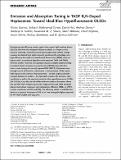Emission and absorption tuning in TADF B,N-doped heptacenes : towards ideal-blue hyperfluorescent OLEDs
Date
05/09/2022Author
Grant ID
838885
812872
RPG-2016-047
SRF\R1\201089
Keywords
Metadata
Show full item recordAbstract
Developing high-efficiency purely organic blue organic light-emitting diodes (OLEDs) that meet the stringent industry standards is a major current research challenge. Hyperfluorescent device approaches achieve in large measure the desired high performance by combining the advantages of a high-efficiency thermally activated delayed fluorescence (TADF) assistant dopant with a narrowband deep-blue multi-resonant TADF (MR-TADF) terminal emitter. However, this approach requires suitable spectral overlap to support Förster resonance energy transfer (FRET) between the two. Here, a color tuning of a recently reported MR-TADF B,N-heptacene core through control of the boron substituents is demonstrated. While there is little impact on the intrinsic TADF properties—as both singlet and triplet energies decrease in tandem—this approach improves the emission color coordinate as well as the spectral overlap for blue hyperfluorescence OLEDs (HF OLEDs). Crucially, the red-shifted and more intense absorption allows the new MR-TADF emitter to pair with a high-performance TADF assistant dopant and achieve maximum external quantum efficiency (EQEmax) of 15% at color coordinates of (0.15 and 0.10). The efficiency values recorded for the device at a practical luminance of 100 cd m–2 are among the highest reported for HF TADF OLEDs with CIEy ≤ 0.1.
Citation
Stavrou , K , Madayanad Suresh , S , Hall , D , Danos , A , Kukhta , N A , Slawin , A M Z , Warriner , S , Beljonne , D , Monkman , A & Zysman-Colman , E 2022 , ' Emission and absorption tuning in TADF B,N-doped heptacenes : towards ideal-blue hyperfluorescent OLEDs ' , Advanced Optical Materials , vol. 10 , no. 17 , 2200688 . https://doi.org/10.1002/adom.202200688
Publication
Advanced Optical Materials
Status
Peer reviewed
ISSN
2195-1071Type
Journal article
Description
This project has received funding from the European Union's Horizon 2020 research and innovation programme under the Marie Skłodowska Curie grant agreement No 838885 (NarrowbandSSL) and under the Marie Skłodowska Curie grant agreement No 812872 (TADFlife). S.M.S. acknowledges support from the Marie Skłodowska-Curie Individual Fellowship (grant agreement No 838885 NarrowbandSSL). The St. Andrews team would like to thank the Leverhulme Trust (RPG-2016-047) for financial support. E. Z.-C. is a Royal Society Leverhulme Trust Senior Research fellow (SRF\R1\201089). Computational resources have been provided by the Consortium des Équipements de Calcul Intensif (CÉCI), funded by the Fonds de la Recherche Scientifiques de Belgique (F. R. S.-FNRS) under Grant No. 2.5020.11, as well as the Tier-1 supercomputer of the Fédération Wallonie-Bruxelles, infrastructure funded by the Walloon Region under the grant agreement n 1117545.Collections
Items in the St Andrews Research Repository are protected by copyright, with all rights reserved, unless otherwise indicated.

